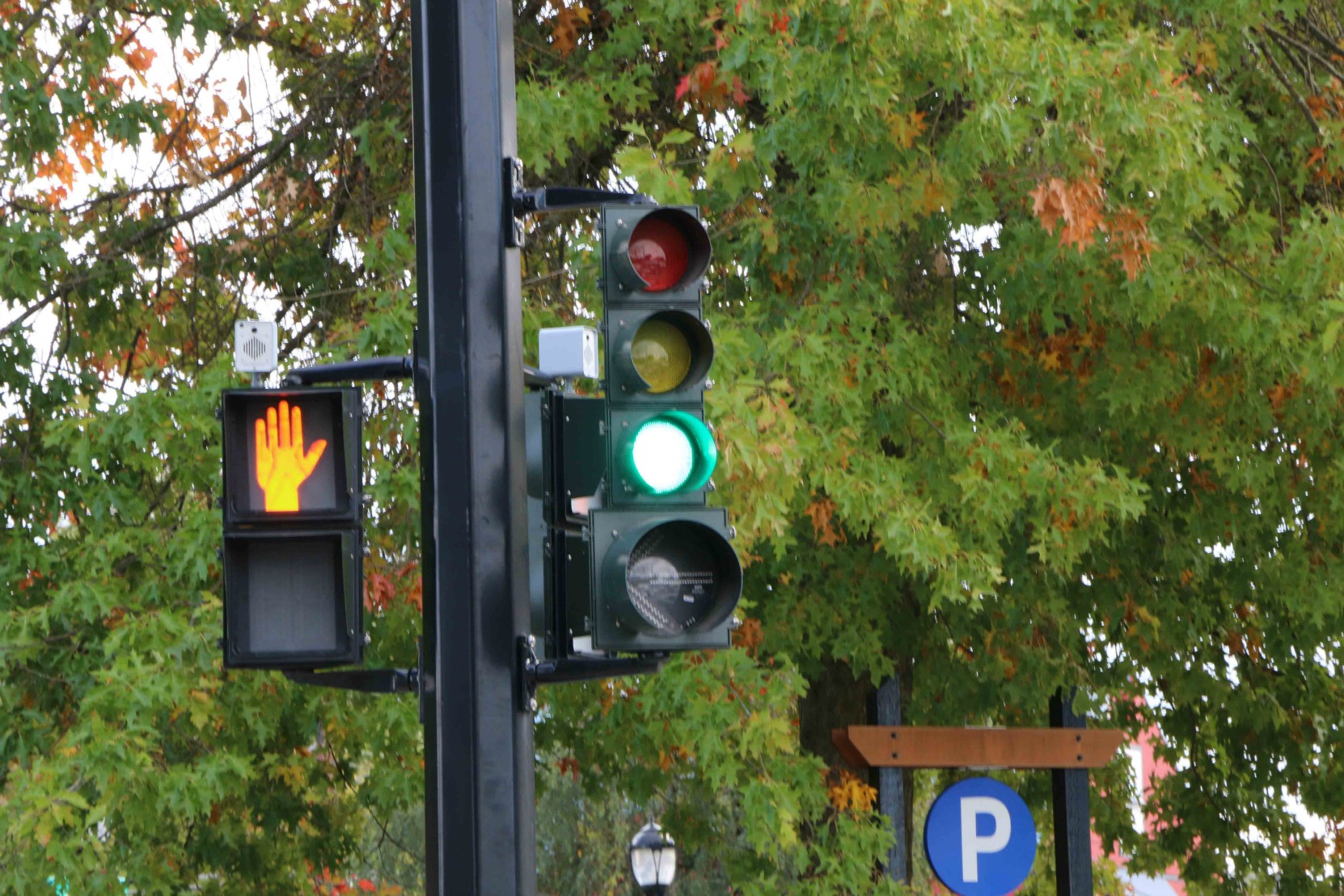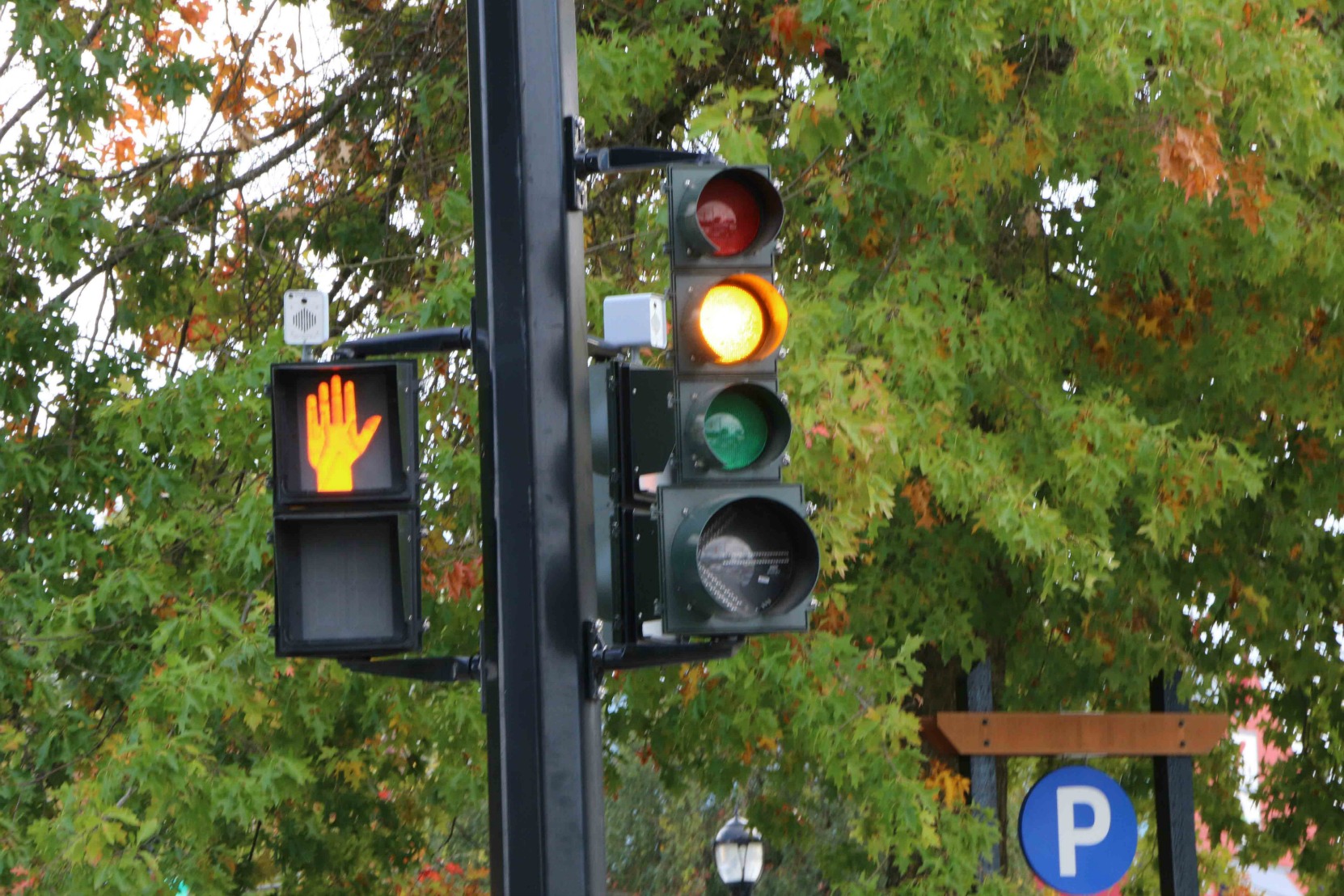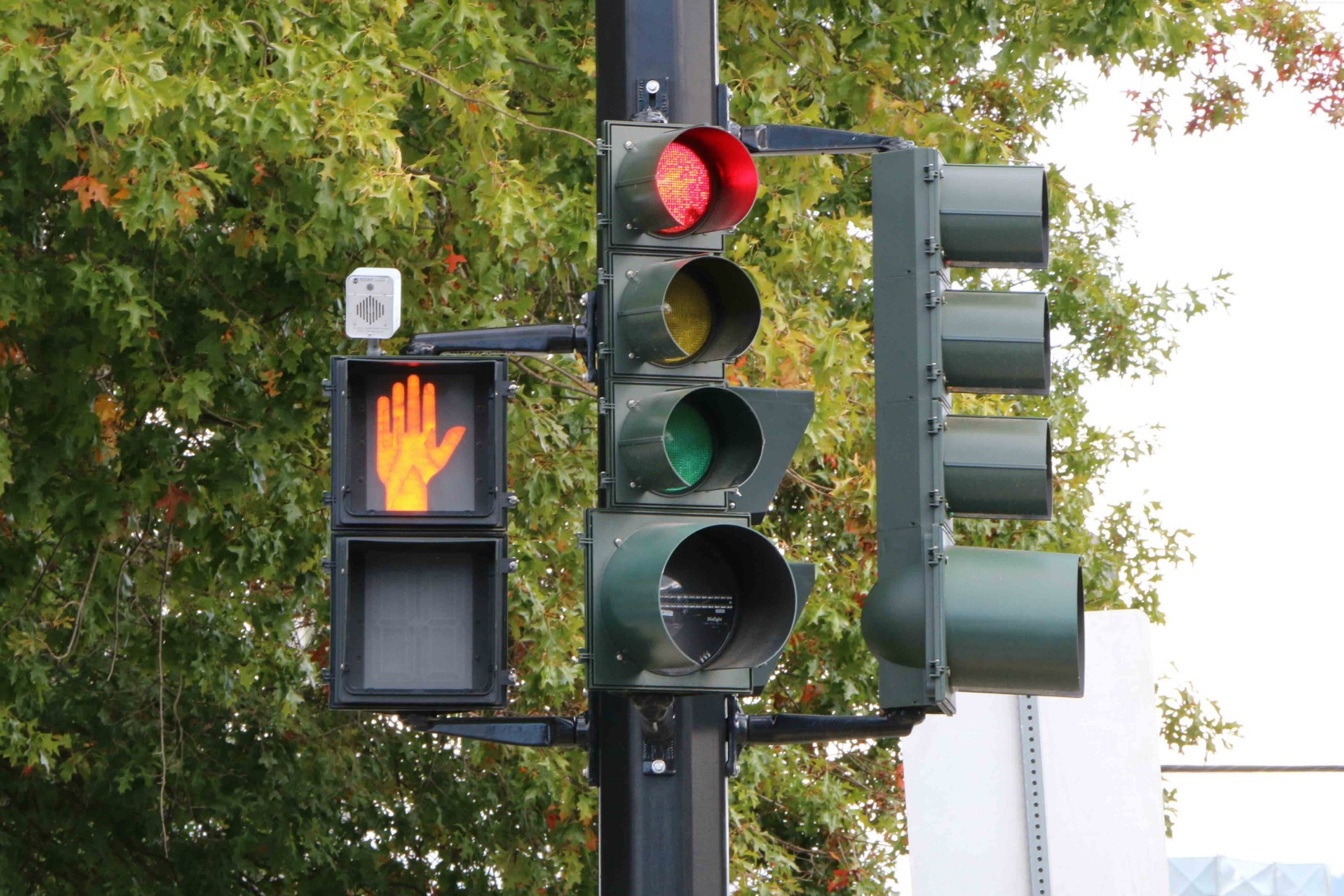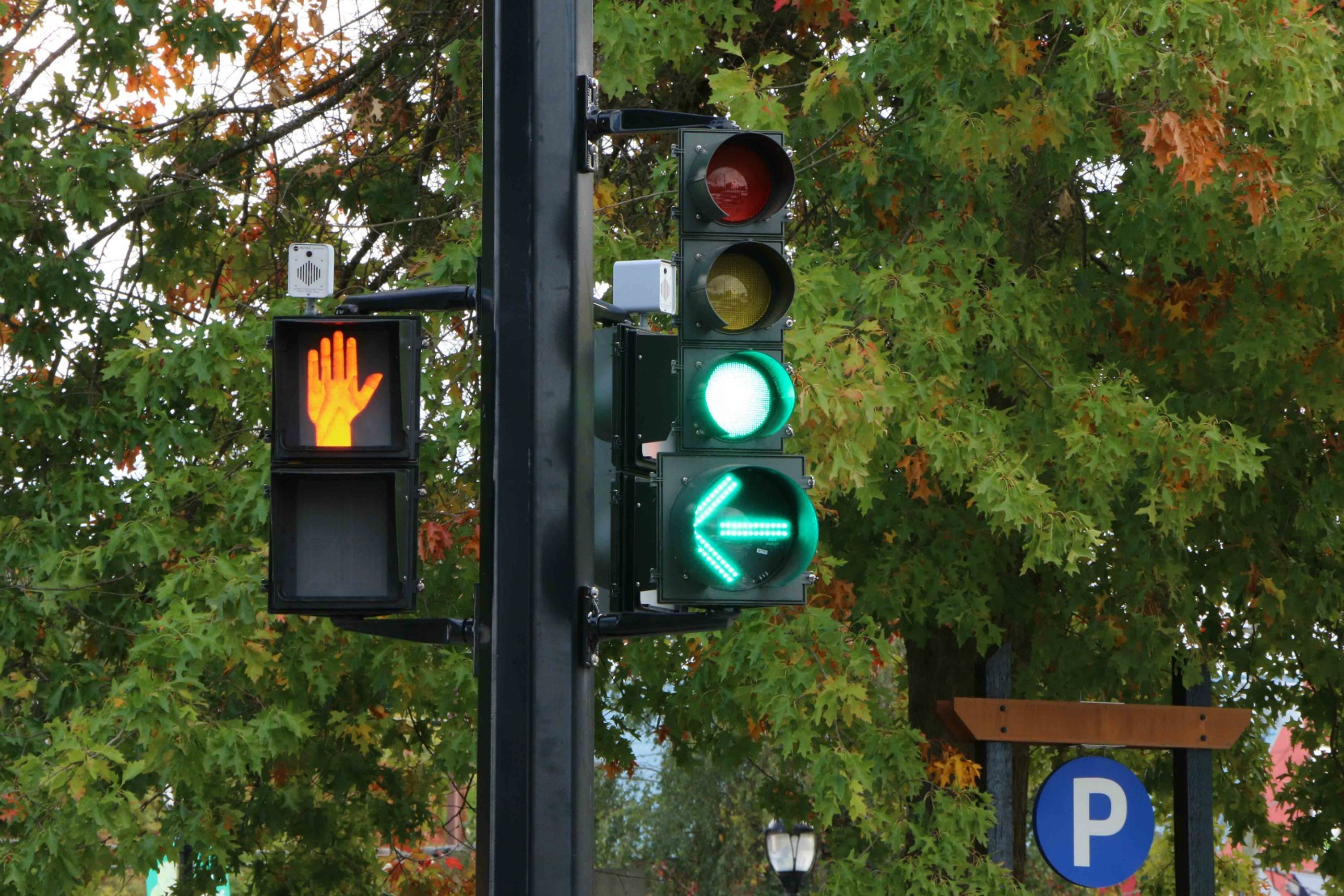In British Columbia the laws on traffic lights are contained in sections 127 (green lights), 128 (yellow or amber lights), 129 (red lights), 130 (arrows), 131 (flashing lights), 132 (pedestrian controls) and 133 (pedestrian controlled signal) of the Motor Vehicle Act.

Green light
127 (1) When a green light alone is exhibited at an intersection by a traffic control signal,
(a) the driver of a vehicle facing the green light
(i) may cause the vehicle to proceed straight through the intersection, or to turn left or right, subject to a sign or signal prohibiting a left or right turn, or both, or designating the turning movement permitted,
(ii) must yield the right of way to pedestrians lawfully in the intersection or in an adjacent crosswalk at the time the green light is exhibited, and
(iii) must yield the right of way to vehicles lawfully in the intersection at the time the green light became exhibited, and
(b) a pedestrian facing the green light may proceed across the roadway in a marked or unmarked crosswalk, subject to special pedestrian traffic control signals directing him or her otherwise, and has the right of way for that purpose over all vehicles.
(2) When a green light alone is exhibited at a place other than an intersection by a traffic control signal,
(a) the driver of a vehicle
(i) may cause the vehicle to pass the signal, and
(ii) must yield the right of way to a pedestrian still in the roadway or on a crosswalk in the vicinity of the signal when the green light is exhibited,
(b) a pedestrian still in the roadway or on a crosswalk in the vicinity of the signal when the green light is exhibited must proceed as quickly as possible from the roadway, and
(c) a pedestrian must not enter the roadway in the vicinity of the signal until either
(i) the traffic control signal facing the vehicular traffic exhibits a red light, or
(ii) a traffic control signal instructs the pedestrian that he or she may cross the roadway.

Yellow light
128 (1) When a yellow light alone is exhibited at an intersection by a traffic control signal, following the exhibition of a green light,
(a) the driver of a vehicle approaching the intersection and facing the yellow light must cause it to stop before entering the marked crosswalk on the near side of the intersection, or if there is no marked crosswalk, before entering the intersection, unless the stop cannot be made in safety,
(b) a pedestrian facing the yellow light must not enter the roadway, and
(c) a pedestrian proceeding across the roadway and facing the yellow light exhibited after he or she entered the roadway
(i) must proceed to the sidewalk as quickly as possible, and
(ii) has the right of way for that purpose over all vehicles.
(2) When a yellow light alone is exhibited at a place other than an intersection by a traffic control signal,
(a) the driver of a vehicle approaching the signal must cause it to stop before entering the nearest marked crosswalk in the vicinity of the signal, or if there is no marked crosswalk, before reaching the signal, unless the stop cannot be made in safety, and
(b) a pedestrian must not enter the roadway in the vicinity of the signal until either
(i) the traffic control signal facing the vehicular traffic exhibits a red light, or
(ii) a traffic control signal instructs the pedestrian that he or she may cross the roadway.

Red light
129 (1) Subject to subsection (2), when a red light alone is exhibited at an intersection by a traffic control signal, the driver of a vehicle approaching the intersection and facing the red light must cause it to stop before entering the marked crosswalk on the near side of the intersection, or if there is no marked crosswalk, before entering the intersection, and subject to the provisions of subsection (3), must not cause the vehicle to proceed until a traffic control signal instructs the driver that he or she is permitted to do so.
(2) The driver of a bus approaching an intersection and facing a red light and a prescribed white rectangular indicator may cause the bus to proceed through the intersection.
(3) Despite subsection (1), and except when a right turn permitted by this subsection is prohibited by a sign at an intersection, the driver of a vehicle facing the red light, and which in obedience to it is stopped as closely as practicable to a marked crosswalk on the near side of the intersection, or if there is no marked crosswalk, as closely as practicable to the intersection, may cause the vehicle to make a right turn, but the driver must yield the right of way to all pedestrians and vehicles lawfully proceeding as directed by the signal at the intersection.
(4) When a red light alone is exhibited at an intersection by a traffic control signal,
(a) a pedestrian facing the red light must not enter the roadway unless instructed that he or she may do so by a pedestrian traffic control signal,
(b) except when a left turn permitted by this paragraph is prohibited by a sign at the intersection, the driver of a vehicle facing the red light at the intersection of not more than 2 highways, and which in obedience to it is stopped as closely as practicable to a marked crosswalk on the near side of the intersection, or if there is no marked crosswalk, as closely as practicable to the intersection, may cause the vehicle to make a left turn into a highway on which traffic is restricted to the direction in which he or she causes the vehicle to turn, but the driver must yield the right of way to all pedestrians and vehicles lawfully proceeding as directed by the signal at the intersection, and
(c) a pedestrian proceeding across the roadway and facing the red light exhibited after he or she entered the roadway
(i) must proceed to the sidewalk as quickly as possible, and
(ii) has the right of way for that purpose over all vehicles.
(5) When a red light is exhibited at a place other than an intersection by a traffic control signal,
(a) the driver of a vehicle approaching the signal must cause it to stop before entering the nearest marked crosswalk in the vicinity of the signal, or if there is no marked crosswalk, before reaching the signal, and
(b) a pedestrian may proceed across the roadway.

Arrows
130 (1) When a green arrow is exhibited at an intersection by a traffic control signal,
(a) the driver of a vehicle facing the green arrow may cause it to enter the intersection and to make only the movement indicated by the green arrow, but must yield the right of way to pedestrians lawfully in the intersection or in an adjacent crosswalk and to other vehicles lawfully in the intersection, and
(b) a pedestrian facing the green arrow must not enter the roadway unless a pedestrian traffic control signal or the exhibition of a green light by a traffic control signal instructs the pedestrian that he or she is permitted to do so.
(2) When a yellow arrow is exhibited at an intersection by a traffic control signal,
(a) the driver of a vehicle approaching the intersection and facing a yellow arrow must cause the vehicle to stop
(i) before entering the marked crosswalk on the near side of the intersection, or
(ii) before entering the intersection, if there is no marked crosswalk,
unless the stop cannot be made in safety,
(b) the driver of a motor vehicle approaching the intersection and facing the yellow arrow may, when a stop cannot be made in safety, proceed with caution to make the only movement indicated by the arrow but must yield the right of way to pedestrians lawfully in the intersection or in an adjacent crosswalk, and to other vehicles lawfully in the intersection,
(c) a pedestrian facing the yellow arrow must not enter the roadway, and
(d) a pedestrian proceeding across the roadway and facing the yellow arrow exhibited after he or she entered the roadway
(i) must proceed to the sidewalk as quickly as possible, and
(ii) has the right of way for that purpose over all vehicles.
Flashing lights
131 (1) When rapid intermittent flashes of red light are exhibited at an intersection by a traffic control signal,
(a) the driver of a vehicle approaching the intersection and facing the flashes of red light must cause the vehicle to stop before entering the marked crosswalk on the near side of the intersection, or if there is no marked crosswalk then before entering the intersection, and must not cause the vehicle to proceed until it is safe to do so, and
(b) a pedestrian facing the flashes of red light may proceed with caution across the roadway, in a marked or unmarked crosswalk.
(2) When rapid intermittent flashes of red light are exhibited at a place other than an intersection by a traffic control signal,
(a) the driver of a vehicle approaching the signal
(i) must cause it to stop before entering the nearest marked crosswalk in the vicinity of the signal, or if there is no marked crosswalk then before reaching the signal, and
(ii) may, after having caused the vehicle to stop, cause it to pass the signal and any crosswalk only if conditions of pedestrian traffic in the roadway or any crosswalk in the vicinity of the signal permit it to do so with safety, and
(b) a pedestrian may proceed across the roadway.
(3) When rapid intermittent flashes of yellow light are exhibited at an intersection by a traffic control signal,
(a) the driver of a vehicle facing the flashes of yellow light may cause it to enter the intersection and proceed only with caution, but must yield the right of way to pedestrians lawfully in the intersection or an adjacent crosswalk, and
(b) a pedestrian facing the flashes of yellow light may proceed with caution across the roadway, in a marked or unmarked crosswalk.
(4) When rapid intermittent flashes of yellow light are exhibited at a place other than an intersection by a traffic control signal,
(a) the driver of a vehicle approaching the signal may cause the vehicle to pass the signal only with caution, and must yield the right of way to pedestrians in the roadway or on any crosswalk in the vicinity of the signal, and
(b) a pedestrian may proceed across the roadway with caution.
(5) When rapid intermittent flashes of green light are exhibited at an intersection or at a place other than an intersection by a traffic control signal,
(a) the driver of a vehicle approaching the intersection or signal and facing the signal must cause it to approach the intersection or signal in such a manner that he or she is able to cause the vehicle to stop before reaching the signal or any crosswalk in the vicinity of the signal if a stop should become necessary, and must yield the right of way to pedestrians lawfully in a crosswalk in the vicinity of the signal or in the intersection, and
(b) a pedestrian may proceed across the roadway with caution and at an intersection only in a marked or unmarked crosswalk.
Pedestrian controls
132 (1) When the word “walk” or an outline of a walking person is exhibited at an intersection by a pedestrian traffic control signal, a pedestrian may proceed across the roadway in the direction of the signal in a marked or unmarked crosswalk and has the right of way over all vehicles in the intersection or any adjacent crosswalk.
(2) When the word “walk” or an outline of a walking person is exhibited at a place other than an intersection by a pedestrian traffic control signal, a pedestrian may proceed across the roadway in the direction of the signal and has the right of way over all vehicles.
(3) When the word “wait”, the words “don’t walk” or an outline of a raised hand are exhibited at an intersection or at a place other than an intersection by a pedestrian traffic control signal,
(a) a pedestrian must not enter the roadway, and
(b) a pedestrian proceeding across the roadway and facing the word “wait”, the words “don’t walk”, or an outline of a raised hand exhibited after he or she entered the roadway
(i) must proceed to the sidewalk as quickly as possible, and
(ii) has the right of way for that purpose over all vehicles.
Pedestrian controlled signal
133 Where a pedestrian is instructed or permitted by a traffic control signal to enter or to proceed across a roadway, he or she must do so
(a) at an intersection, only in a marked or unmarked crosswalk, and
(b) at a place other than an intersection, in the vicinity of which there is a marked crosswalk, only in the crosswalk.
Would you like to leave a comment or question about anything on this page?